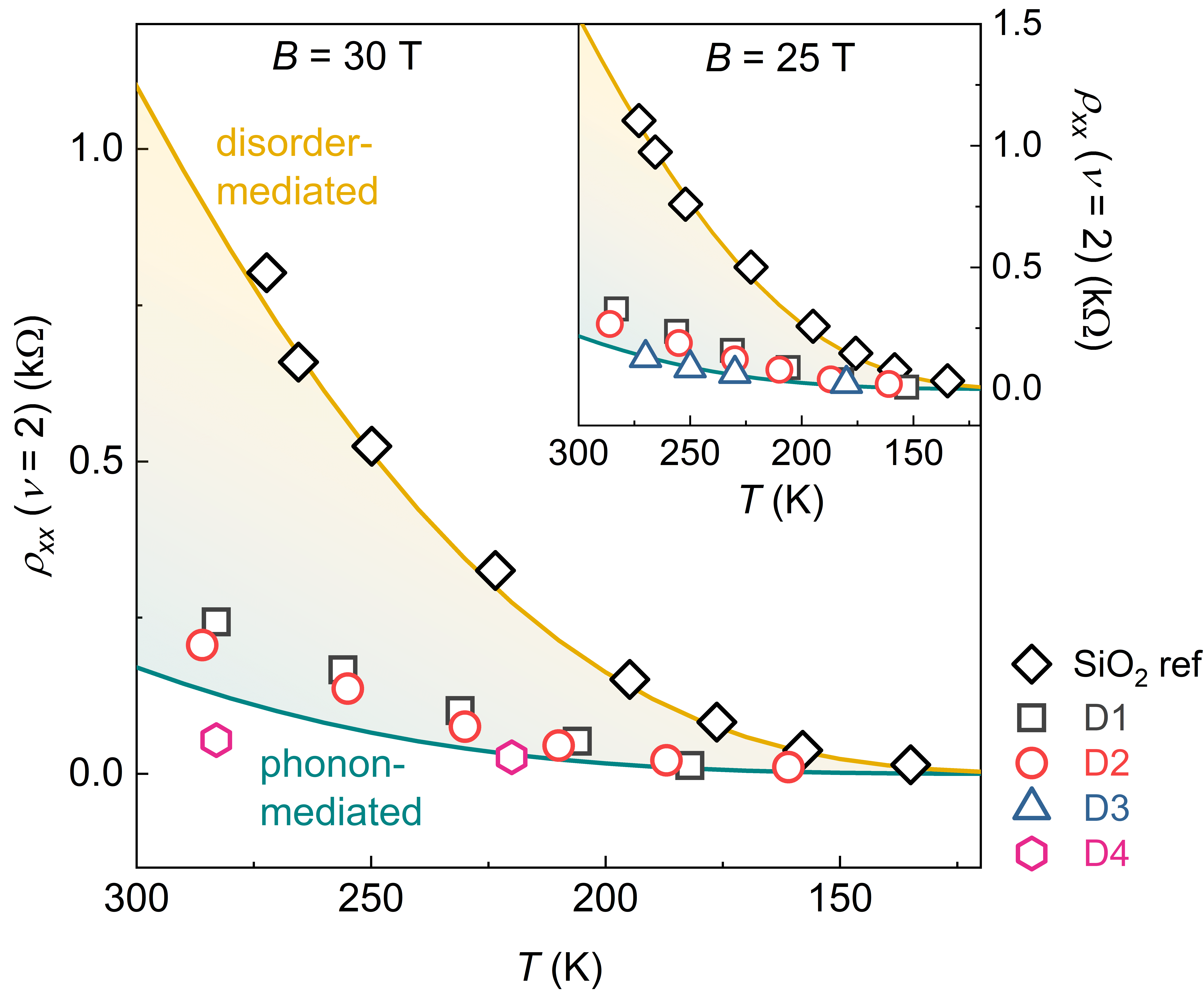Uli Zeitler, Steffen Wiedmann, HFML Nijmegen and Sergio Pezzini, Istituto Nanoscienze-CNR Pisa.
The quantum Hall effect (QHE), a paradigmatic phenomenon of twodimensional (2D) electron systems in high magnetic fields, typically occurs only at very low temperatures of a few kelvin. Under these conditions, lattice vibrations (so-called phonons) are suppressed and, thus, play a marginal role in the electrical transport. Graphene, the purely 2D form of carbon, stands out from its 2D peers due to a giant energy gap between its first two Landau levels (LLs), which enables the observation of quantum Hall states up to room temperature (RT, ~300 K). Indeed, already more than 15 years ago, high magnetic fields crucially contributed to the first observation of this RT-QHE in graphene. However, only samples resting on SiO2 had been studied in this regime, potentially missing out intrinsic physics due to detrimental substrate-induced disorder. Now, a team of researchers from the Istituto Nanoscienze-CNR Pisa, the University of Salamanca, RWTH Aachen University, the Radboud University and HFML Nijmegen have investigated a collection of high-quality graphene samples encapsulated in hexagonal boron nitride (hBN, provided by researchers at NIMS). In zero field, the RT conductivity of these van der Waals sandwiches is known to be chiefly limited by electron-phonon scattering. What happens if one applies a magnetic field strong enough to realize the RT-QHE? Bearing this question in mind, the team made use of the HFML-EMFL facility to measure the so-called thermally activated resistivity, with the devices set to filling factor 2 where the most pronounced quantum Hall plateaus develops. As the temperature is increased toward RT, mobile charge carriers are excited across the LL gap. The consequent exponential increase in the resistivity directly relates to the gap size, as well as to the underlying carrier scattering mechanism. Despite their LL gap being equal, the activated resistivity of the graphene-hBN devices turned out to be strikingly lower with respect to that of disordered reference samples. On the one hand, graphene on SiO2 could be described by parameters associated to long-range disorder, not differently from the standard low-temperature QHE. On the other hand, the new data strikingly follows a recent theoretical model by Alexeev et al., in which the temperature and fielddependent activated conductivity is ascribed to two-phonon-electron scattering alone. Thanks to the data collected over several high-field runs, the researchers were able to reproduce this phenomenon in different samples, whilst finding a correlation between deviations from the RT-QHE phonon-limit and their zero-field charge-carrier mobility. The observation of phonon-mediated quantum-Hall transport marks yet another unique property of graphene, underlying the central role of van der Waals technology for the study of transport phenomena in 2D.

Figure: Thermally activated resistivity at ν = 2 in different hBN-encapsulated graphene devices (D1-D4), measured at B = 30 T (main panel) and 25 T (inset). The dark cyan and yellow solid lines are calculated curves, defining two different dissipation limits in the QH phase.
Phonon-mediated room-temperature quantum Hall transport in graphene, D. Vaquero, V. Clericò, M. Schmitz, J. A. Delgado-Notario, A. Martín-Ramos, J. Salvador-Sánchez, C. S. A. Müller, K. Rubi, K. Watanabe, T. Taniguchi, B. Beschoten, C. Stampfer, E. Diez, M. I. Katsnelson, U. Zeitler, S. Wiedmann, and S. Pezzini, Nat. Commun. 14, 318 (2023).
https://www.nature.com/articles/s41467-023-35986-3
Contact: sergio.pezzini@nano.cnr.it uli.zeitler@ru.nl steffen.wiedmann@ru.nl






